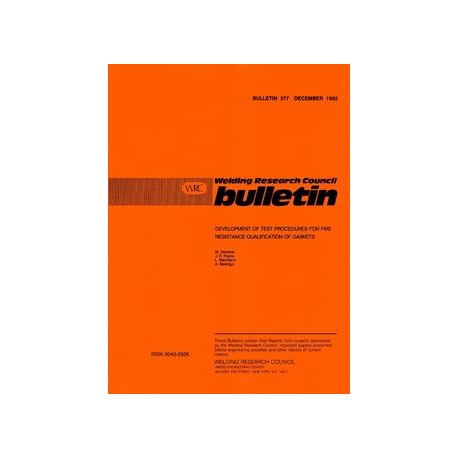Cart
0
Product
Products
(empty)
No products
To be determined
Shipping
$0.00
Total
Product successfully added to your shopping cart
Quantity
Total
There are 0 items in your cart.
There is 1 item in your cart.
Total products
Total shipping
To be determined
Total
New
Reduced price!
 View larger
View larger
 View larger
View larger
WRC 377
M00009694
New product
WRC 377 Development of Test Procedures for Fire Resistance Qualification of Gaskets
Bulletin / Circular by Welding Research Council, 1992
M. Derenne, J. R. Payne, L. Marchand, A. Bazergui
In stock
More info
Full Description
Background on the development of a simulated fire testing program for fire resistance qualification of gaskets and fire testing of different types of gaskets was covered in this bulletin. Publication of this document - WRC Bulletin No. 377 was sponsored by the Committee on Bolted Flanged Connections of the Pressure Vessel Research Council. The research work was performed under PVRC Grant Nos. 88-16 and 89-03.The fire exposure survivability is an important aspect of gasket qualification for many process applications and the evaluation of the fire resistance is a key property to be considered for the acceptance of new products.
This report summarizes the background on the development of a simulated fire testing program sponsored by the Pressure Vessel Research Council and the Material Technology Institute. The first part is concerned with fire test considerations and the early development of simple fire test procedures, based on the mechanical integrity of gasket materials after exposure to simulated fire conditions. The second part deals with a more recent and a more sophisticated fire survival test based on the joint tightness under a simulated fire exposure.
Both procedures were investigated on various sheet gasket materials (asbestos and non-asbestos) and composite gaskets (spiral wound gaskets). Useful correlations of test results obtained with these procedures were possible through these developments. The simple mechanical fire test could thus suffice to characterize the fire resistance of sheet gaskets, unless proof of tightness has to be made. The fire tightness test, on the other hand, is better adapted to composite gaskets (Double jacketed, spiral wound, etc.).

